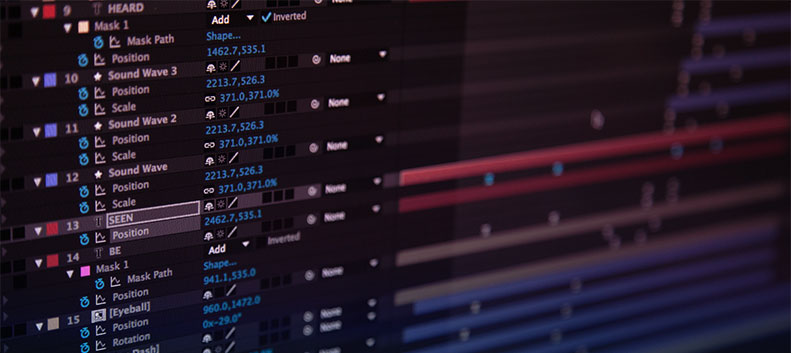Motion Graphics

Motion graphics
As attention spans continue to decrease in an oversaturated market, consumer conversion demands engaging and entertaining content. Motion graphics, which is, graphic design in motion, can make all the difference in getting your message across simply and dynamically. Motion graphics elevate graphic design to the next level by putting design elements such as objects, shapes, images, and text into motion. These can be animated to add additional value to your content. Even without a specific narrative, motion graphics can enliven your logos, videos, presentations, and social media posts.
Motion graphics break down complex ideas into something that consumers can understand, conveying important information in a memorable and less time consuming way. They can be created using a pre-existing animation or animation can be added to flat graphic elements in your content library using a visual editor. With motion graphics, you have limitless potential and control over your content, and can incorporate your brand message through your choice of colour, shape, sound, and movement. Research has proven that motion graphics increase your retention, click through, and conversion rates, and all without too much investment.
For example, according to a study by Microsoft, the average attention span of humans is eight seconds and is decreasing by a massive eighty eight percent each year. This means that most online content will be scanned, with uninteresting content being largely ignored. Graphics and interesting visuals have the power to circumvent this by appealing to the senses, attracting consumer attention to give you the results you need. This is statistically proven, as it has been shown that 95% of messages in videos are retained, compared to only 10% in text. This means that consumers are more likely to remember a message when motion graphics are used. In addition to this, a study by MIT showed that humans process visual information in just thirteen milliseconds, making visual communication highly effective. Motion graphics operate with these biological processes, making it an invaluable way to convey complex information.
The appeal of motion graphics to consumers also lies in its ability to evoke emotions. When well-done, they offer vast opportunities for your content to be liked, seen and shared on social media sites. In fact, social videos elicit twelve times more shares than text and images combined. This makes it an ideal choice for social media posts, ads, presentations, and promotions. In the case of social media posts and ads, motion graphics can boost brand engagement and awareness by making your content more engaging. On Twitter, for example, tweets using GIFs boast 55% more engagement than those without. Most motion graphics range from 30 seconds to 3 minutes long, letting you make a far-reaching impact with less content. According to a Facebook study, even watching 10 seconds of a social media ad with motion graphics is enough to increase brand awareness.
There are three main categories of motion graphic videos that can be used to fulfill your marketing purposes. The first is the emotive motion graphic, whose primary purpose is to elicit a strong emotional response from the viewer that motivates them to take action. The explainer video, in contrast, aims to distill abstract concepts into a clear picture that viewers can easily comprehend. This may include visual tutorials, illustrating how something works, or helping viewers visualise data. Finally, the main goal of the promotional video is to drive conversions. This type of video acts as a sales piece and is used to sell a product or service. Another popular use of motion graphics is for the creation of attractive and dynamic icons and logos that can positively reflect the company’s brand. These are very cost efficient as they can serve the company well for many years.
Motion graphics can be used in numerous channels of the marketing campaign, such as traditional television or online ads, instructional videos and tutorials, social media content, brand promotional videos, and culture marketing videos, allowing companies to showcase their brand, value, and mission across diverse platforms. The making of a motion graphic generally entails scripting and scene direction, storyboarding, art direction, animation, and sound design. The combination you choose will depend on your intended purpose and the viewing environment. A successful motion graphic must be well designed, communicate a strong narrative, and showcase real creativity.
By 2022, it is estimated that 82% of internet traffic will be video views, many of which will be content marketing videos. Investing in well crafted motion graphics is a wise move in your content marketing strategy as they have a good return on investment and have been found to help businesses grow revenue almost 50% faster.
Colour grading
Colour is critical in marketing as it has the ability to change marketing assets so that they fit the goals of production. It can be used to make assets more or less realistic, or to deliver the desired emotional and psychological effect. Colour grading can elevate a good image to an outstanding one that has a definitive impact, and is conducive to your final product meeting its maximum potential.
Colour is integral to branding and marketing as it’s proper use has been proven to increase brand recognition and perception. It conveys emotions and feelings to your consumers that drive decision making and is therefore an important element of your brand identity. Colour grading can deliver a message to customers in a matter of seconds. For example, colours that define cultural eras can be used to arouse feelings of nostalgia, or to appeal to a more subconscious level, the brand’s colours can be subtly integrated into the advertisement.
Colour grading is typically done by primary and secondary colour types. With primary, the density for red, blue, and green are overlaid across the entire frame. With secondary, they are used to regulate the hue, saturation, or brightness of the image. These qualities all help to determine how the image is perceived by viewers. For example, blue hues tend to make images appear colder, whereas yellow and orange ones make them appear warmer. Or, as another example, online ads aiming for a more cinematic feel will be de-saturated and have a high contrast between darker colours and whites.
This process is applicable to both still and moving images. When a photo is taken, the raw image often appears flat and lifeless. Colour grading enhances the colour, saturation, and contrast of the image, and is used by photographers to communicate a specific mood or intent. The most popular colour grading softwares are DaVinci Resolve 16, Red Giant Magic Bullet Colorista IV or Adobe Premiere Pro. Online photo editors such as Pixlr or Fotor may also be used. These dedicated tools leverage the power of colour to influence the tone of the original image. The raw file can be manipulated in post production to achieve a particular look or mood, rather than accepting the JPEG file straight from the camera.
Colour grading in motion is not a novel concept. One of the key goals of colour grading in video production is that the end product is as professional and realistic as possible and that potential distractions from the intended message are minimized. Your messaging strategy can be enhanced by amplifying certain aspects of the video to elicit strong reactions in your audience. For moving images, softwares such as Adobe Speedgrade and DaVinci Resolve may be used. Some video editing software such as Adobe After Effects also have built in colour grading tools. Colour grading is done before editing and influences the direction of the final product, giving importance to a concrete understanding of colour psychology in use.
Choosing the ideal palette for your advertising content is a blend of aesthetic, testing, and science. This very much affects how buyers perceive your product, thus directly affecting sales. In fact, data shows that colours can be a very effective persuasive tool, with 85% of consumers citing colour as their primary reason for choosing one product over another. Up to 90% cite their impulse decisions as being based solely on colour. This extends to more than just products, with close to 50% of consumers naming colour as a prime contributing factor to their impression of a company’s website. These data show that the correct use of colour is crucial to producing successful marketing materials.
Understanding how colour can be harnessed to fulfill consumer needs and expectations is vital to your marketing agenda. Colour grading provides an efficient and cost-effective way to do this, producing high-impact content with a unique, persuasive, and professional look.
Our services
- Copy transcreation
- Brand guardianship
- Cross-cultural consultancies
- Translation
- Creative production
- Production decoupling
- Digital content production
- Content production
- Dynamic creative optimisation
- Media delivery
- Media clearance
Get the Ultimate Guide to Production Decoupling.
Download your free guideGet 20% off your first project
Simply fill out the form below with as much detail as you can, and we’ll send you a quote within 24hrs — that includes your first-time 20% discount.
